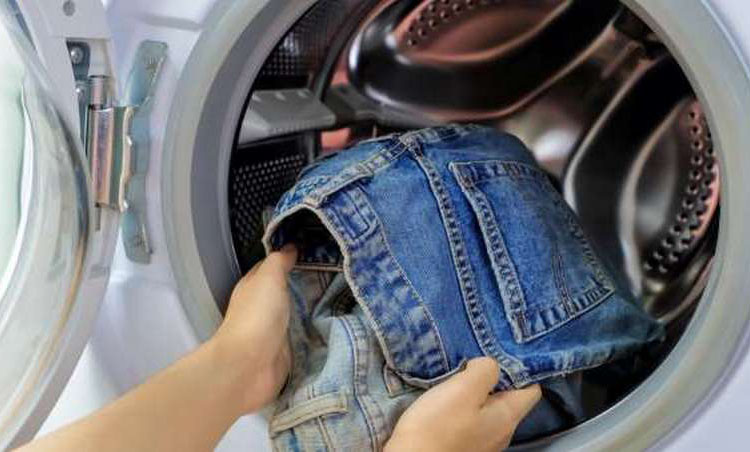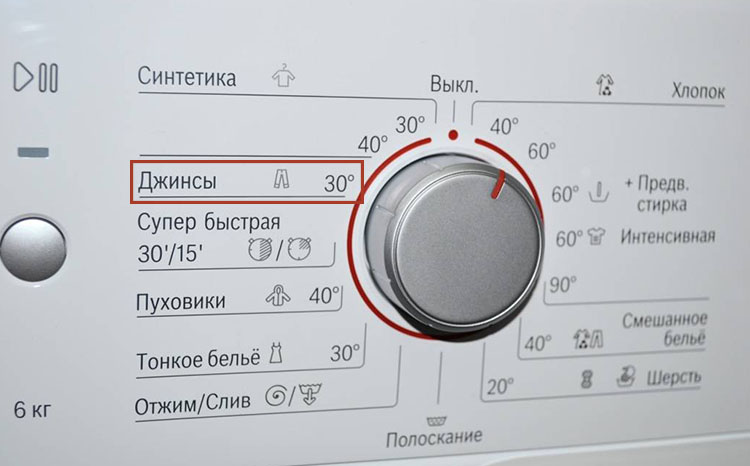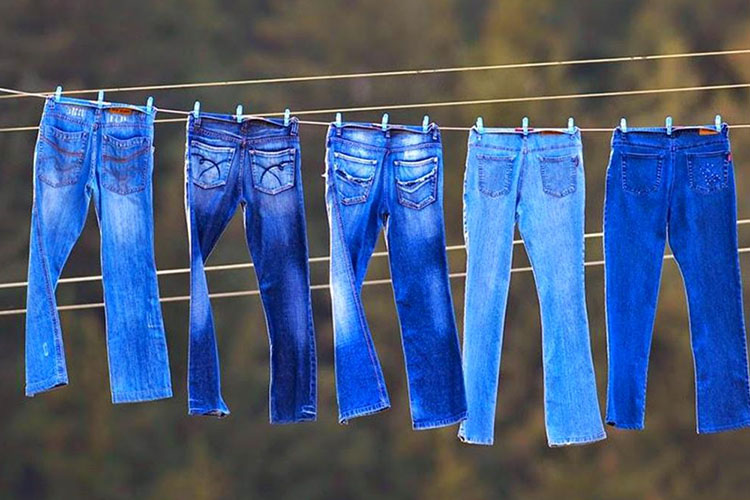How to wash jeans in a washing machine without losing color and whether washing with other laundry is allowed
Care will extend the life of your favorite pair of jeans. We will tell you about the rules of washing, drying, spinning products made of denim.
Contents
Jeans fabric varieties
The fabric is distinguished by its composition, the technology of weaving threads, the method of dyeing. The type of denim fabric determines the quality, durability of the finished product.
Classification:
- Denim. Classical strong smooth fabric. Formed by interweaving two-color fibers based on cotton extra long. Warp yarns are blue, weft yarns are bleached, undyed. The underside is significantly lighter than the front side. Indigo dye does not penetrate into the fibers, deposited on the surface. The material is undemanding in care, but during the washing dye is gradually washed away, jeans lighten.
- Broken twill, twill. Fabric with a characteristic right-, left-handed twill weave. Reminiscent of the pattern of "herringbone" on the diagonal of the fabric. Varies in thickness, density of threads. Broken lines form a dense texture that will last for years. Original Wrangler models are made of twill.
- Stretch, Lycra. Cotton canvas with synthetic fibers. More often manufacturers use elastane, less often - Chinese nettle rami. Denim fabric stretches, models the figure. Capricious in the washing material. Improper care leads to shrinkage, loss of elastic properties.
- Genie. Monochrome blue cotton fabric. Made from cheap varieties of cotton. Large global brands apply gin in the most budget models. Requires delicate treatment.
- Chambray. Light melange fabric of cotton. Strands are woven without shifting, at right angles. It is a base for laconic, comfortable cloth for everyday wear: shirts, tunics, dresses.
- Eikru (ecru). Untreated cotton, linen material of undyed yarn. Color depends on the type, quality of fiber and manufacturing technology.
It is customary to distinguish sanforized and raw denim. Sanforized treatment reduces shrinkage and shedding due to the maximum washout of dye.
Stiff denim without factory treatment looses indigo and shrinks in size when washed for the first time.
What temperature to wash jeans at.
Jeans require timely cleaning. Send the garment to the washing machine as needed, when you need to return it to its proper appearance and hygienic condition.
Do not overdo it with care. On average, you can use the washing machine once every 1-2 weeks or less.
When choosing a temperature, consider the recommendations on the label. Information label contains rules for washing, drying and ironing. Products are sewn from different materials, care for each pair is individual.
Automatic washing modes:
- "Delicate".
- "Gentle.
- "Manual".
- "Fast 30".
- "Jeans.
Avoid hot modes of automatic washing machines. High temperature will spoil the thing, lead to deformation, shrinkage, stretching. The color will become lighter, the decor will be damaged.
Do not use programs with high speeds. Intense spinning leads to indigo washout, formation of fractures. The optimal number of revolutions is 400-600. The highest allowable drum speed is 800.
In between automatic washes, use alternative care methods.
Ways to freshen up your jeans:
- Hang them out in the fresh air for 12 hrs.
- Place in a bag, put in the freezer for 3 to 5 hours.
- Leave under hot steam in a bathtub for 1 to 2 hours.
Remove small spots with a damp sponge.
What detergent to use
Use phosphate-, enzyme-, and bleach-free detergents. Aggressive substances wash out the color, leading to the destruction of fabric fibers.
Means for washing denim fabrics:
- Household bulk laundry detergent - mild, no bleach.
- Liquid detergent gels.
- Powders with the addition of laundry soap.
- Special detergents for denim.
- Oxygen detergents - for colored, mixed fabrics.
- Color stabilizers - for dark-colored fabrics.
- Delicates - for garments with appliques, embroidery, leather, lace inserts.
The package of the product indicates the dosage, which should be observed. The detergent requires thorough rinsing.
Stain Removal and Whitening
For the pretreatment of difficult dirt, use cleaning products for natural fabrics: powders, gels, laundry soap and improvised means.
Soak
Soaking the garment in a cleaning solution will remove most of the dirt. Dissolving the stains with water and detergents will make washing easier.
Technology:
- Fill a container with water at 40 ° C.
- Prepare the solution. Dilute the detergent according to the instructions.
- Turn the product inside out.
- Immerse in water with the solution. If the garment floats, apply a burden.
Allow the jeans to soak for 3 hours, then place them in the washer drum.
Soaking after purchase.
A new item requires pretreatment.
With sanforized denim, soaking will remove excess substances after manufacturing, help to fix the indigo dye, and reduce the loss of coloration due to friction.
Raw denim is soaked to pre-shrink the fabric.
Technology:
- Fill the tub. Use 40°C water for raw denim, 20-30°C for sanforized denim.
- Add 1 cup of vinegar and sea salt.
- Turn the thing inside out, immerse it in the water. Place a weight.
Allow the dumplings to soak for 1 to 2 hours. Rinse, remove item, do not wring out water.
Allow to dry hanging from a rope.
Laundering and Stain Removal
Difficult stains require preliminary manual cleaning. A soft brush, sponge, cotton pads, paper towels are used for washing.
Washing algorithm with preliminary stain removal:
- Study the label.
- Choose a laundry detergent.
- Study the dosage information.
- Select the wash mode.
- Shake off the dust with a brush, pre-treating the stain by hand.
- Wash.
Grease, oil stains
Sprinkle a fresh, greasy stain with tooth powder, salt, or starch, and let it set for about 10 minutes. Carefully remove the powder with a paper towel.
For stubborn stains, use a dishwashing detergent. Unlike other stains, wash at not more than 30°C. This will prevent grease, oil from sticking.
Coffee, food
Prepare an emulsion to remove traces of coffee drinks: 2-3 drops of alcohol, a little warm water, egg yolk. Apply the mixture to the stain for 10 minutes, wash off with a sponge.
Remove food stains with carbonated water and salt (250 ml/10 g). Apply the solution by rubbing with a clean cotton pad. You can treat with household detergent, stain remover or laundry soap.
Wine stains
Blot a fresh stain with a white, dry cloth, removing any excess liquid.
Turn the jeans inside out, rinse the stain with plenty of cold water. On the front side, apply detergent. Allow to stand for 5-10 minutes, then wash.
Paint Stains
Soak water emulsion paint with warm water and dish detergent. Use thinner, medical alcohol or nail polish remover for oily stains.
Leave the soaked stain for 20-30 minutes, then wash the thing in the machine.
Grass, leaf stains
Allow the stain to dry first, then scrape off the dirt. When chunks of dirt are removed, apply a household cleaner or a thick layer of shavings of laundry soap. Rub gently.
After 30-40 minutes, wash at an acceptable temperature for the product.
Recommendations:
- If you are using a stain remover, apply the solution on a spot so as not to damage the fabric around it. The exposure time is shown on the package.
- Clean light colored jeans with hydrogen peroxide. Spread the product liberally on the stain, leave it for 20 minutes.
If a stain has formed on a pair from street dirt, you can not immediately scrub it with water. The fabric will have an ugly brightened stain.
Wait until the stain dries, then gently, without excessive force, wipe with a brush. Turn the item inside out, wash with warm water without detergents, send it to the wash.
Blood stains
Blood stains are afraid of cold water.
Stain Removal Technology:
- Fresh stain. Soak the area with a cloth, soak for 20-30 min. send to an automatic washing machine.
- Older stain. Clean the stain with dishwashing gel, salt, soda, or use a solution of cold water and washing up liquid. Soak for 10-15 minutes. Take out of the water, blot the blood as much as possible and wash.
Is Washing Permitted with Other Clothes
It is recommended that dark and light denim be washed separately from all other items. It is acceptable to load with jeans of the same color, similar texture fabrics.
Do not mix with delicate materials.
To prevent fading, reduce friction, take no more than 3-4 items at a time.
Prepare for the wash
Do the sorting, distribute the items by color. For especially soiled jeans, conduct soaking or laundering operations.
Algorithm of preparation:
- Fasten zippers, bolts.
- Check pockets, remove all items. Remove belts, suspenders. This will protect the machine from breakage. The item will remain intact, without unpredictable stains.
- Turn the item inside out. This will help protect the item from damage, fading from machine washing. Spread out the item.
- Place items with patches, appliques, prints, rhinestone decorations, and beads in a bag.
Load into the drum, set the washing mode in cool water.
Do you need a fabric softener?
Conditioner will preserve color, add fragrance, and make it easier to iron denim. Use a cleaner to care for classic denim without impregnation.
Do not add it to wash jeans with elastane. The rinse aid will clog the fibers, - the product will lose shape, size.
Rules of Application:
- Strict adherence to the dosage. Too much rinse aid will ruin the fabric. Jeans will become tough, will quickly get dirty, will lose their breathability.
- Concentrate pre-diluted with water according to the instructions.
- The agent is added to a special compartment of the washing machine, not to the powder.
Squeezing and drying
Turn off the spin function of the automatic washing machine. The mode will cause unnatural, unsightly highlighted creases.
After washing, hang the garment so that all the water drains out. Do not hand wring or twist.
Drying:
- Do not machine dry. Automatic tumble drying is the worst enemy of jeans. Aggressive temperature exposure leads to color loss, shrinkage, and damage. Do not dry over an open heat source.
- Hang the garment outdoors in places without direct sunlight. Hang on a clothesline, hanger, or dryer. Straighten creases, irregularities, turn inside pockets to dry faster.
- Do not bend the product, hang it by the waist, the tightest part. No peg marks will remain here. Jeans will dry evenly, without wrinkles.
- Do not leave jeans in the machine drum. Moisture will provoke rust from buttons and other metal parts.
Improper care is the cause of premature wear, shedding, shrinkage, and deformation of jeans. Textiles lose their original color and durability.
Follow the simple recommendations and the thing will last a long time.
Useful video
Here's a short video introduction to how to correctly wash your jeans in the washing machine:









